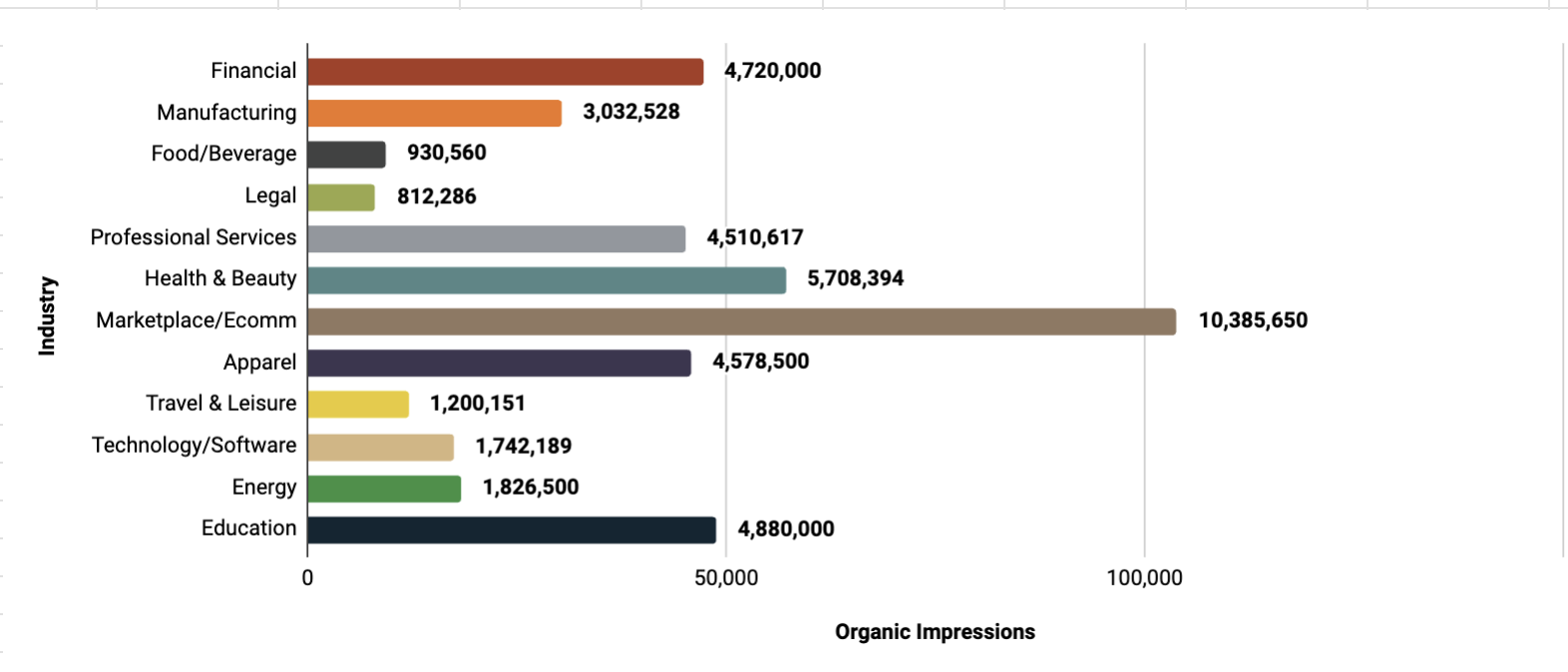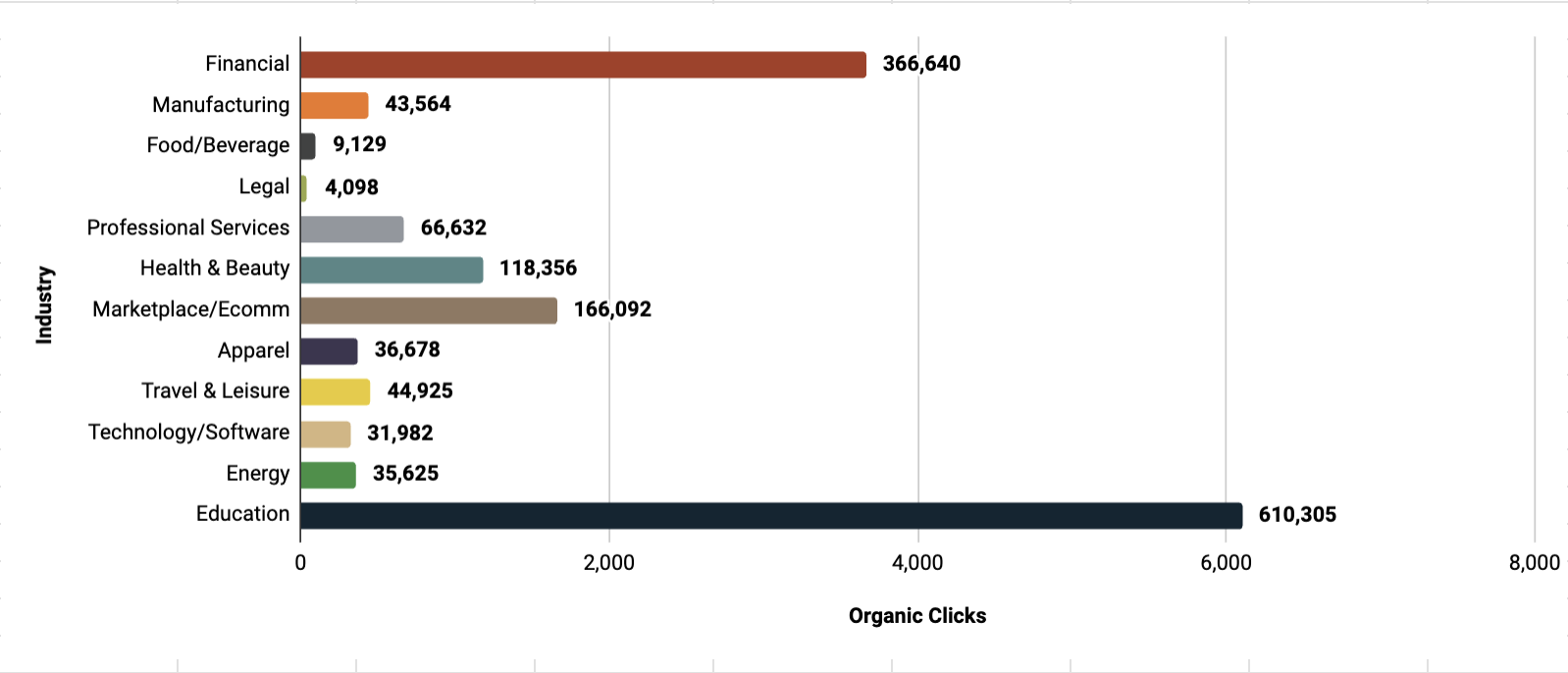What is Industry Benchmarking?
Overview
Industry benchmarking helps businesses assess their SEO performance by comparing key data points, including impressions, organic clicks, and engagement metrics, against competitors. This report presents insights based on data from industries Zero Gravity Marketing worked with throughout 2024, providing a snapshot of where different sectors stand in organic search.
Purpose
By analyzing these benchmarks, businesses can:
✔ Identify areas where they excel or lag behind competitors
✔ Adjust SEO strategies to improve search rankings and engagement
✔ Set realistic performance goals based on industry data
How We Find the Data
The SEO benchmark report below is based on data collected from Google Analytics 4 (GA4) and Google Search Console (GSC). The following metrics were used:
- Impressions: How often a website appears in search results
- Organic Clicks: The number of clicks from search results
- Click-Through Rate (CTR): The percentage of users who click after seeing the website
- Average Position: The typical ranking of a site in search results
- Organic Sessions: The number of visits from organic search
- Engaged Sessions: Sessions where users remained active
- Organic Views: Pageviews generated from organic search
- Key Events: Important user actions, such as form submissions
By averaging data across multiple industries, we created a baseline for measuring SEO effectiveness.
The Data – SEO Benchmarks by Industry
Below are visual breakdowns of SEO performance across industries based on ZGM's 2024 data:
Impressions by Industry
Highest Impressions: Marketplace/eCommerce (10,385,650)
Lowest Impressions: Legal (812,286)
Median Impressions: 3,693,948
💡 Tip: Improve impressions by expanding keyword strategy, optimizing page structure, and increasing high-quality backlinks.
Organic Clicks by Industry
Most Clicks: Education (610,305)
Fewest Clicks: Legal (4,098)
Median Clicks: 127,835
💡 Tip: Strengthen title tags and meta descriptions to encourage more clicks. Use action-oriented language and rich snippets for better visibility.
Average Click-Through Rate (CTR) by Industry
Highest CTR: Education & Travel/Leisure (4%)
Lowest CTR: Manufacturing, Legal & Apparel (1%)
Median CTR: 2.20%
💡 Tip: To increase CTR, ensure title tags are compelling, descriptions are engaging, and URLs are structured clearly.
Average Position by Industry
Best Position: Travel & Leisure (21)
Lowest Position: Legal (42)
Median Position: 27.6
💡 Tip: Improve rankings by focusing on technical SEO, content creation, backlink-building, and page experience.
Organic Sessions by Industry
Most Organic Sessions: Education (2,948,062)
Fewest Organic Sessions: Legal (6,562)
Median Organic Sessions: 267,724
💡 Tip: Increase organic sessions by producing high-quality content, updating pages regularly, and improving internal linking.
Organic Engaged Sessions by Industry
Highest Engaged Sessions: Education (1,675,503)
Lowest Engaged Sessions: Legal (4,484)
Median Engaged Sessions: 290,661
💡 Tip: Keep users engaged by improving site speed, enhancing readability, and adding interactive elements like videos.
Organic Views by Industry
Most Views: Education (7,394,817)
Fewest Views: Legal (12,263)
Average Views: 1,134,595
💡 Tip: Optimize older pages, create more long-form content, and use schema markup for better indexing.
Key Events by Industry
Most Key Events: Health & Beauty (245,674)
Fewest Key Events: Legal (374)
Median Key Events: 42,202
💡 Tip: Improve conversions by refining call-to-actions (CTAs), simplifying forms, and using clear landing page layouts.
Contact Us
How to Use Benchmarking to Improve SEO Performance
Benchmarking provides a clear path to refining your SEO approach. Here’s how to apply this data to your digital strategy:
1. Identify Your Strengths and Weaknesses
- Are your impressions high but your CTR low? This may indicate weak title tags and meta descriptions.
- Are your organic sessions lower than industry averages? You might need better keyword targeting.
- Is your average ranking position lower than your competitors? A stronger backlink profile and content updates may help.
2. Set Data-Driven Goals
Use industry benchmarks to create specific, measurable goals based on:
- Increasing CTR by X% within six months
- Boosting organic sessions by optimizing older content
- Improving ranking position by targeting long-tail keywords
3. Adjust Your SEO Strategy Based on Metrics
- Low CTR? Test different meta titles and descriptions using A/B testing.
- Poor Rankings? Build backlinks through guest posting and PR efforts.
- Few Organic Clicks? Improve page speed, mobile experience, and content relevance.
4. Monitor Changes and Optimize Continuously
SEO is always changing, so be sure to regularly check GA4 and GSC to track improvements and adjust as needed to stay competitive.
FAQs
Which SEO KPIs Matter Most?
The most critical SEO KPIs vary by business goals, but key ones include:
✔ Organic search traffic
✔ Click-through rate (CTR)
✔ Keyword rankings
✔ Bounce rate
✔ Conversion rate
What Is Benchmarking in SEO?
Benchmarking in SEO means assessing your website’s search performance compared to industry averages, helping you determine where to improve.
How Do I Know If My SEO Is Performing Well?
Compare your organic search traffic metrics with industry data. If your numbers exceed the benchmark, your SEO is strong. If they’re lower, adjustments may be needed.
Contact SEO Specialists at ZGM
If you're looking to improve your SEO benchmark metrics, Zero Gravity Marketing can help. We work with businesses across multiple industries to strengthen their organic search performance and drive measurable results.
Contact us today to start refining your SEO strategy!



















